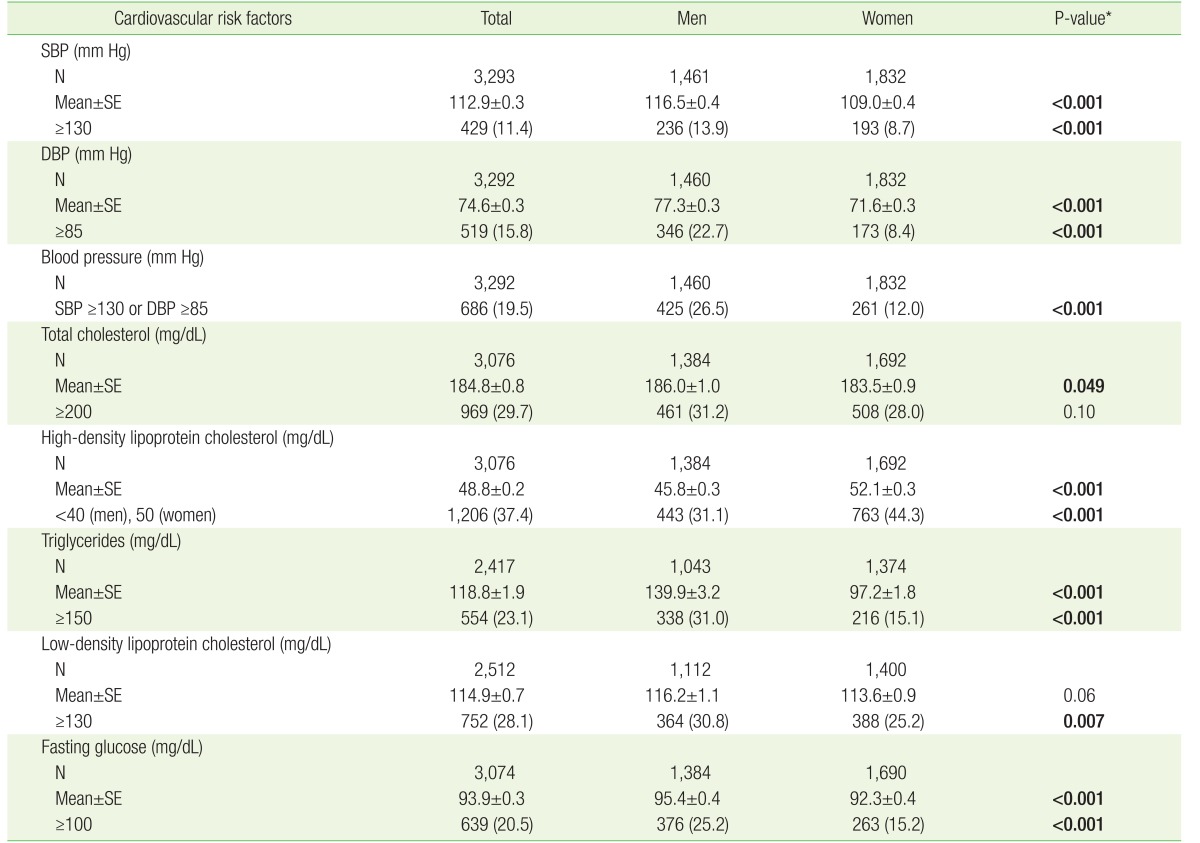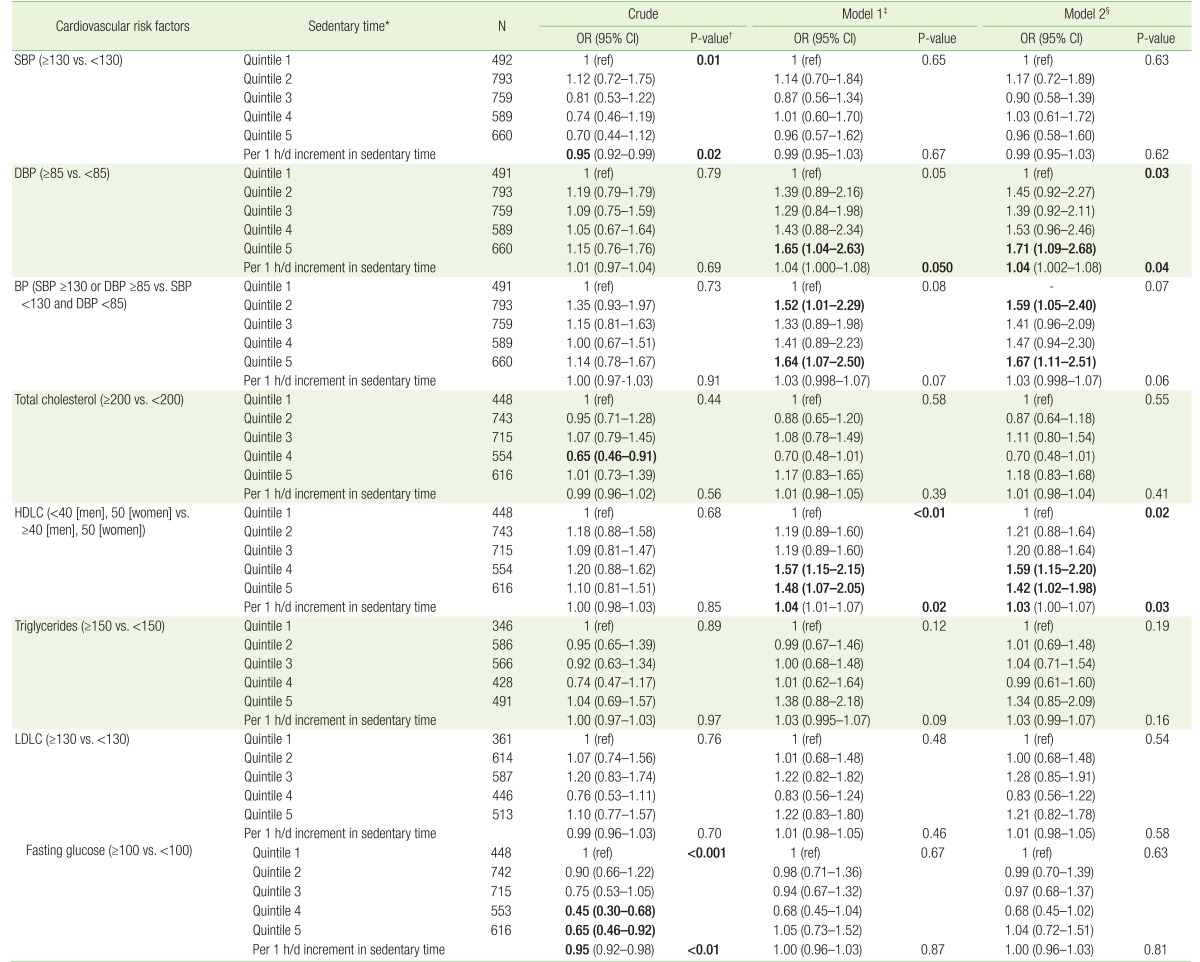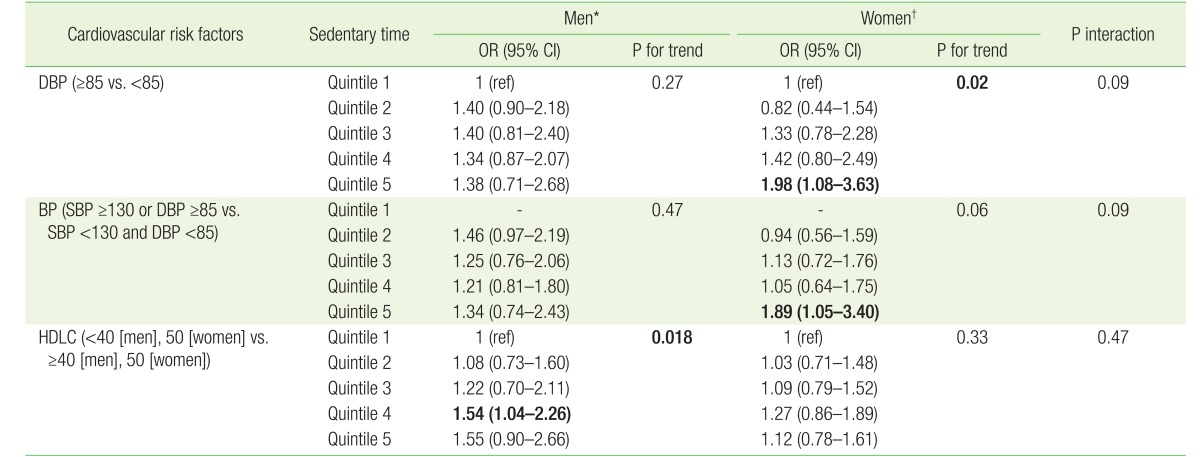 |
 |
- Search
| Korean J Fam Med > Volume 39(1); 2018 > Article |
Abstract
Background
Methods
Results
References
Table┬Ā1
Sociodemographic characteristics of study participants (2013 Korean National Health and Nutrition Examination Survey)

Values are presented as mean┬▒standard error or number (%), unless otherwise indicated after survey analysis. The sum of each subgroup is not same because of missing data. Statistically significant results are marked in bold.
MET, metabolic equivalent of task; MVPA, moderate-to-vigorous physical activity.
*T-tests for continuous variables and chi-square tests for categorical variables. ŌĆĀQuartiles were generated using monthly average household equivalent income in the same sex and age groups. ŌĆĪBereaved, divorced, separated, or no response. ┬¦Based on average physical activity levels (METs). Inactive job includes manager, specialist, office worker, and unemployed (housewife, student), and active job includes service worker and seller, foster and fishery worker, machine operator and assembler, and simple labor worker. ŌłźTertile cutoff points were 1,626 and 2,281. ┬ČMVPA includes walking and moderate and vigorous physical activities. Cutoff points for tertile were 594 and 2,034 MET-min/wk. **Quintile cutoff points were 3.0, 4.5, 6.0, and 9.5 h/d.
Table┬Ā2
Cardiovascular risk factors of study participants (2013 Korean National Health and Nutrition Examination Survey)

Values are presented as number (%), unless otherwise stated. Means, standard errors, and proportions are presented after survey analysis. Statistically significant results are marked in bold.
SBP, systolic blood pressure; SE, standard error; DBP, diastolic blood pressure.
*T-tests for continuous variables and chi-square tests for categorical variables.
Table┬Ā3
ORs and 95% CIs of cardiovascular risk factors according to sedentary time

All values are presented after survey analysis. Statistically significant results are marked in bold.
OR, odds ratio; CI, confidence interval; SBP, systolic blood pressure; ref, reference; DBP, diastolic blood pressure; BP, blood pressure; HDLC, high-density lipoprotein cholesterol; LDLC, low-density lipoprotein cholesterol.
*Quintile cutoff points were 3.0, 4.5, 6.0, and 9.5 h/d (quintile 1 [<3.0], quintile 2 [3.0ŌĆō4.5], quintile 3 [4.5ŌĆō6.0], quintile 4 [6.0ŌĆō9.5], and quintile 5 [Ōēź9.5]). ŌĆĀThe first P-values are Ptrend, and the second P-values are statistical significance of ORs. ŌĆĪAdjusted for age, sex, education level (below high school/high school/above high school), income level (quartile), marital status (couple/single/others), type of occupation (inactive/active), residence (urban/rural), menopausal status (premenopause/menopause), smoking status (non-smoker/ex-smoker/current smoker), alcohol intake (non/moderate/heavy), and calorie intake (tertile). ┬¦Based on model 1, model 2 was further adjusted for body mass index (low to normal/overweight/obese), waist circumference (normal/abdominal obesity), and moderate-to-vigorous physical activity (tertile).
Table┬Ā4
ORs and 95% CIs of cardiovascular risk factors according to quintiles of sedentary time by sex

All values are presented after survey analysis. Adjusted for age and sex, education level (below high school/high school/above high school), income (quartile), marital status (couple/single/others), occupation (inactive/active), residence (urban/rural), menopausal status (premenopause/menopause), smoking (non-smoker/ex-smoker/current smoker), alcohol (non/moderate/heavy), calorie intake (tertile), body mass index (low to normal/overweight/obese), waist circumference (normal/abdominal obesity), and moderate-tovigorous physical activity (tertile). Statistically significant results are marked in bold.
OR, odds ratio; CI, confidence interval; DBP, diastolic blood pressure; ref, reference; BP, blood pressure; SBP, systolic blood pressure; HDLC, high-density lipoprotein cholesterol.
*Sedentary time quintile cutoff points were 3.0, 5.0, 6.25, and 10.0 h/d for men (quintile 1 [Ōēż3.0], quintile 2 [3.0ŌĆō5.0], quintile 3 [5.0ŌĆō6.25], quintile 4 [6.25ŌĆō10.0], quintile 5 [>10.0]). ŌĆĀSedentary time quintile cutoff points were 3.0, 4.75, 6.0, and 9.5 h/d for women (quintile 1 [Ōēż3.0], quintile 2 [3.0ŌĆō4.75], quintile 3 [4.75ŌĆō6.0], quintile 4 [6.0ŌĆō9.5], quintile 5 [Ōēź9.5]).
- TOOLS







